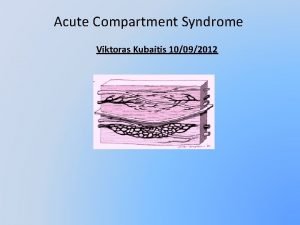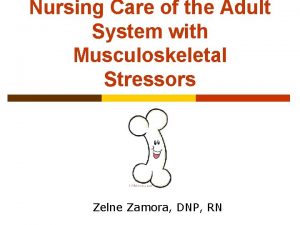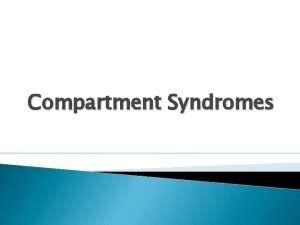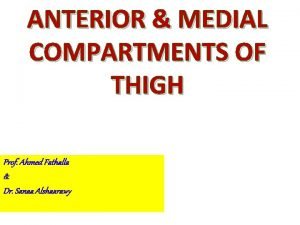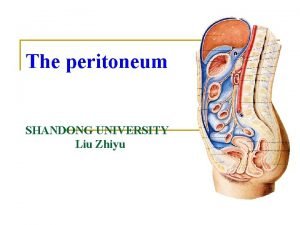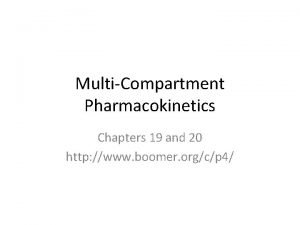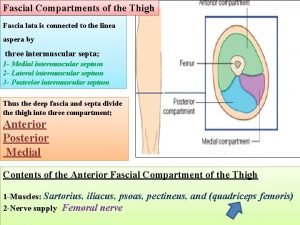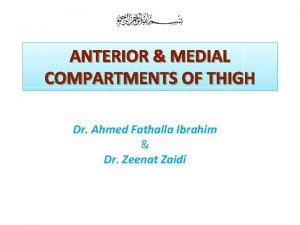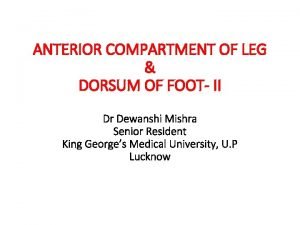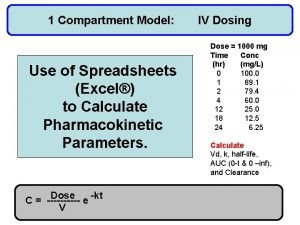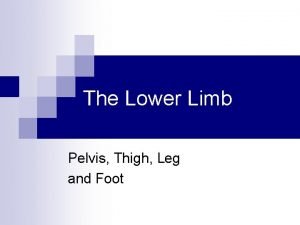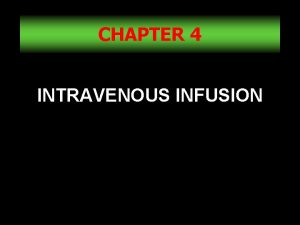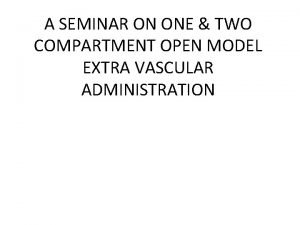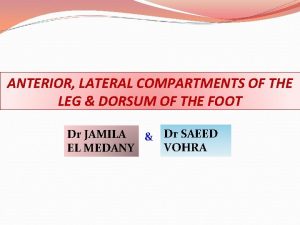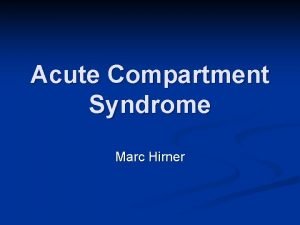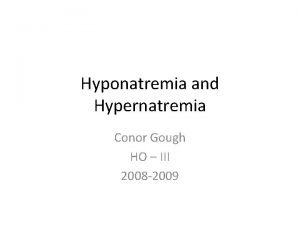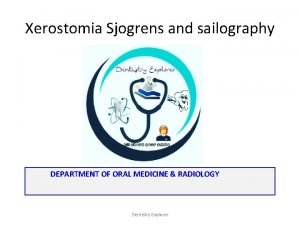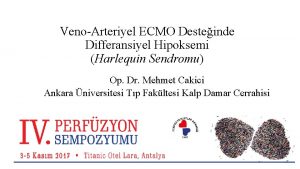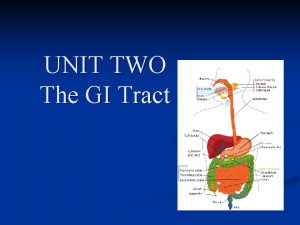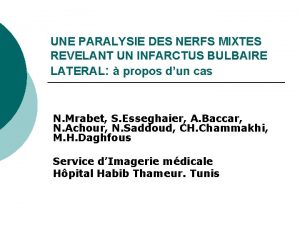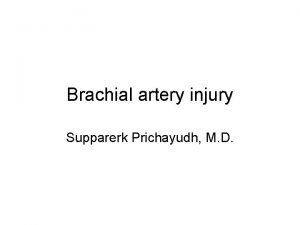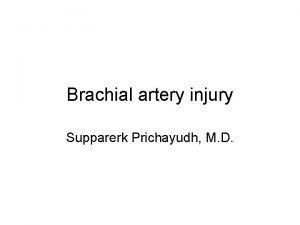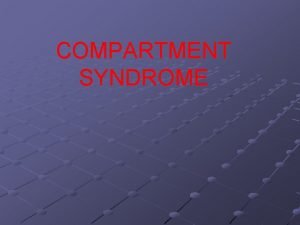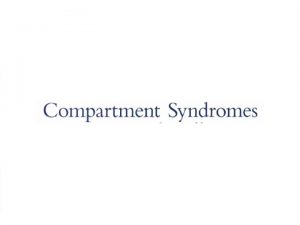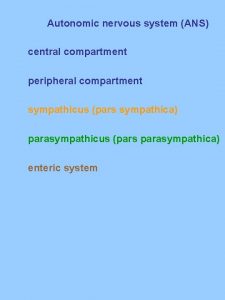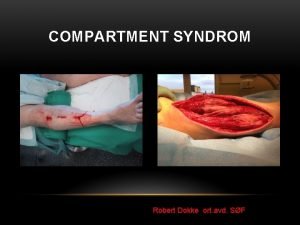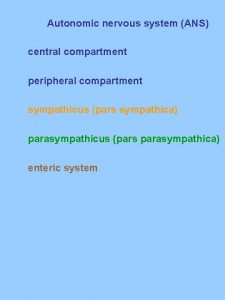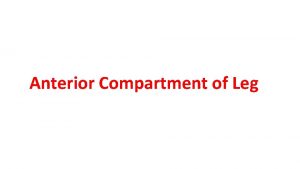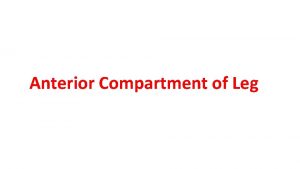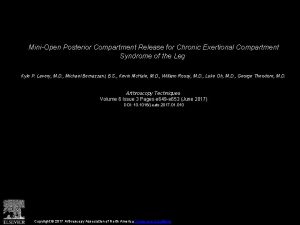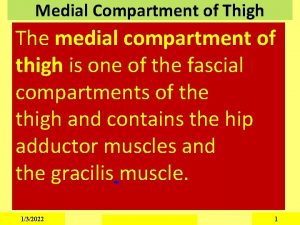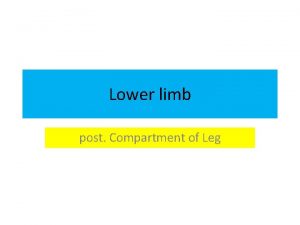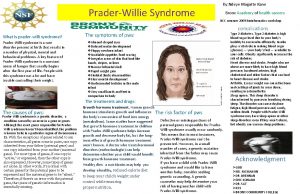Compartment syndrome and fasciotomy Supparerk Prichayudh M D





































































- Slides: 69

Compartment syndrome and fasciotomy Supparerk Prichayudh, M. D.

What is Compartment Syndrome? • Matsen’s definition 1980 – “a compartment syndrome is a condition in which increased pressure within a limited space compromises the circulation and function of the tissues within that space. ”



Where can it occur? • Anywhere there is an enclosed space typically restricted by fascia: – Upper Arm – Forearm – Hand – Thigh – Chest – Abdomen • Raised ICP of the brain

Causes of Compartment Syndrome (Primary) • Fracture of the long bones e. g. Tibia • Crush injuries • Burns Eschar • Lithotomy position • Pneumatic tourniquet • High Injury Trauma • Ischemia/Reperfusion • Penetrating injuries

Secondary Extremity Compartment Syndrome • Rare, 0. 08 -0. 148% • part of the post-resuscitation SIRS • significant edema and associated compartment syndromes in 2 to 4 injured or non-injured extremities after massive resuscitation. • Mortality rate 35 -70% • should be suspected in any injured patient who presents with profound hypotension, ISS > 25, transfusion of at least 10 units of PRBC • Rx: early detection and early fasciotomy

Pathophysiology Tissue Injury + Tissue Ischemia +Tissue Reperfusion Cellular injury & Tissue swelling ↑ compartment pressure Compartment syndrome

CS Pathogenesis Soft tissue injury/ischemia edema As pressure rises VR causing P Tissue perfusion- arterial compression Capillaries starting shutting down Capillary leakage Tissue Death Cellular Ischemia superoxide Radicals, procoagulants (esp. during reperfusion) Cellular & interstitial edema

Local blood flow

Compartment pressure (normal 4 -7 mm. HG) ↑ > Capillary pressure (>25 -30 mm. Hg) prevents perfusion of tissues ischemia and ultimately death of tissue.

Reactive Oxygen Metabolite ( ROM ) - Unpaired outer orbit electron of Oxygen from Anaerobic Glucose Oxidation (Ischemia) + O 2 (Reperfusion) → Superoxide Anion ( O 2 - ) → Hydrogen Peroxide ( H 2 O 2 )/ Hydroxyl Radical (OH-) - High energy and reactivity with organic molecules → Organic Radicals → Cellular damage (oxidation of unsaturated fatty acid within cell membrane)

• ROM – OH– H 2 O 2 – O 2 - Strongest • Body antioxidant (oxygen scavenger) – Glutathione – Catalase – Superoxide dismutase weakest - 2 O 2 + 2 H+ Superoxide dismutase 2 H 2 O 2 catalase H 2 O 2 + 1 O 2 H 2 O + O 2

What are its consequences? • If not recognised and not treated myoneural necrosis occurs due to tissue p. H as a result of lactic acidosis from anaerobic metabolism and a release of K+ • Myoglobin is released leading to rhabdomyolysis the products of this lead to acute tubular necrosis (ATN) acute renal failure (ARF) • sepsis and death can result • So it is important to act swiftly once the diagnosis is suspected

Tissue Threshold to Ischemia • • • Muscle 4 -8 hrs Nerve 4 -8 hrs Fat 12 hrs Skin 24 hrs Bone 72 -96 hrs Therefore for a viable functional limb the upper threshold is about 6 hrs

Anatomy

Arm Compartments Anterior Posterior

Forearm compartments Volar Lateral (Mobile WAD) Dorsal

Thigh compartments Anterior (flexor) Medial (adductor) Posterior (flexor)

Compartments of the Leg

Compartments of the Lower Anterior Compartment Limb Deep Posterior – main extensors of the leg Compartment – flexors Superficial Posterior of the foot and–great Compartment toe superficial flexors • Anterior. Compartment Tibialis, Lateral Extensor Hallicus and • Peroneus Longus and digitorum Longus, brevis Peroneus Tibia • Deep peroneal nerve Superficial peroneal nerve • 1/3 blood supply to lower leg via Dorsalis • Plantar flexes foot Pedis and Anterior Tibialis • compartment syndrome – get foot drop • Loss of sensation skin between first and second toes • Weakness of toe extension pain on toe flexion Fibula • Flexors of foot and Gastronemius great toe • Soleus • Tibeal Nerve • Sural & Tibial Nerves • 2/3 blood supply to • Plantar flexors lower leg via posterior tibial artery • Blood supply posterior tibial • Weakness of toe flexion and ankle inversion, pain on passive extension Fascia

• Anterior Compartment is more susceptible to ischemia: • Stronger fascia lower compliance (c= v/ p ) • More slow type 1 muscle fibres – rely on oxidative metabolism. Other compartments have more fast type 2 which can access their increased glycogen stores more via anaerobic metabolism

Diagnosis Clinical Compartment Pressure

The 5 components of a physical examination • Inspection (swelling, trauma, skin changes) • Palpation and passive stretch of muscles in the compartments • Evaluation of sensory function • Evaluation of motor function • Evaluation of perfusion

• Nerves are sensitive to diminished oxygen delivery – Sensory change & Weakness Late signs • The presence of palpable pulses at the ankle or wrist in the injured extremity does not rule out the presence of a more proximal compartment syndrome.

CS with high pressure tapering of major arteries and temporary occlusion of collateral arteries (rare) Crush injury of forearm Before fasciotomy After fasciotomy

Clinical Diagnoses Symptoms & Signs: • Deep aching Pain out of proportion to the injury • Incredible pain on passive movement of leg – due to stretched ischemic muscles • As arterial supply cut off - Pulselessness • Paresthesia - distally • Pallor • Perishing Cold • Paralysis • Tight tense swollen limb • Redness, mottling, blisters • 6 P’s may or may not be present; cannot exclude condition based on their absence







Compartment Pressures • (1) when a comprehensive history and physical examination cannot be performed in the preoperative or postoperative period. • (2) when there are no or few “high risk” criteria in a patient with a moderately severe injury to an extremity • (3) when there is concern about performing an unnecessary fasciotomy (ie, conversion of closed to open fracture).

NS

A-line tubing & transducer • Use of a 16 -gauge needle attached to arterial tubing & connected to a standard transducer/monitor. • After flushing the tubing and needle with saline, the needle is held just above the compartment, and a “ 0” reading is obtained on the monitor. • The needle is then placed into the compartment, a small amount of saline is flushed, and a direct reading is soon available on the monitor. • When the pressure measurement is inconsistent with the clinical situation, a repeat measurement or more at another site is appropriate.


Near-Infrared Spectroscopy (NIR) • measures wavelengths of hemoglobin and oxyhemoglobin, but not carboxyhemoglobin or myogloblin, and calculates an St. O 2 or saturation of tissue oxygenation. • tissue oxygen saturation can be used for early detection of ischemia and/or neuromuscular dysfunction in patients with a compartment syndrome in an extremity.

Treatment 1. Prevention and treatment of reperfusion injury 2. Non operative treatment 3. Fasciotomy

1. Reperfusion Injury - Ischemic phase; Cellular Hypoxia → ↓Energy → ↑Potential to produce ROM( anaerobic glucose metabolism) - Reperfusion phase ( After revascularization, fasciotomy ); O 2→ ↑ROM → Tissue destruction, Rhabdomyolysis (↑ CPK) return of toxic metabolites to systemic circulation (ROM, K+, Bacteria, myoglobin, etc) Hyperkalemia, sepsis, myoglobinuria, ATN, MOF

Rx reperfusion injury - 1. Prevention - Decrease ischemic time - Never reperfuse dead limb !!! - 2. Rx hyperkalemia - 3. Prevent RF Prevent myoglobin precipitation in renal tubules - Hydration, promote urine flow > 100 cc/hr, alkalinize urine - 4. Mannitol promote diuresis, antioxidant - 0. 25 -2 g/kg/dose over 4 hours, total < 200 g/d - C/I hypovolemic, anuric patients - 5. antioxidant (vitamin C, E, selenium) - 6. Dialysis if indicated

2. Non operative treatment • • (rarely used, in stable patients with good limb function & perfusion) Observation Position of the Extremity Hyperbaric Oxygen Mannitol

3. Fasciotomy • a surgical incision or splitting of the fascia to relieve a compartment syndrome • Principles – Timely – Adequate incisions (skin and fascia)

Indications for Fasciotomy • • S & S of compartment syndrome compartment pressure > 30 - 35 mm. Hg ∆P (DBP-CP) < 30 mm. Hg Prophylactic – – any popliteal artery injury any combined arterial and venous injury prolonged extremity ischemia > 4 -6 h vascular injury associated with shock; crush injuries; combined skeletal and vascular extremity trauma; and the ligation of a major extremity vein or artery.

Reis, et al. Israel J Bone Joint Surg 2005 • Fasciotomy is contraindicated for these reasons: – 1) A fasciotomy for MMCI does not improve outcome (muscle is already dead). – 2) It does increase infection, bleeding and amputation rates. – 3) The fasciotomies and subsequent debridements required consume scarce OR resources that could be better used on others • Only indication for fasciotomy Absence of distal pulse without major arterial injury/ hypotension • Rx conservative, fluid resuscitation


Thigh compartments Anterior (flexor) Medial (adductor) Posterior (flexor)

Fasciotomy of the Thigh Lateral skin incision anterior and posterior compartments Decompression of thigh compartments. A, Incision from intertrochanteric line to lateral epicondyle. B, Anterior compartment is opened by incising fascia lata, and vastus lateralis is retracted medially to expose lateral intermuscular septum, which is incised to decompress posterior compartment. C, Drawing of thigh compartments and appropriate incision.

Fasciotomy of the Leg 2 -skin incision, 4 -compartment fasciotomy

Fasciotomy of the Anterior and Lateral Compartments of the Leg

Fasciotomy of the Superficial & Deep Posterior Compartment of the Leg.

Foot compartments Intrinsic Medial Lateral Central

Fasciotomy of the Foot

Arm Compartments Anterior Posterior

Fasciotomy of the Anterior and Posterior Compartments of the Arm

Forearm compartments Volar Lateral (Mobile WAD) Dorsal

Fasciotomy of the Forearm



Fasciotomy of the Hand

Closure Techniques • Delayed Primary Closure • Shoelace Technique • Mechanical Devices – STAR (Suture Tension Adjustment Reel) – Dynamic Wound Closure Device (DWC) • Vacuum Assisted Closure • Skin Grafting





Anchoring shell STAR Winding shell -13 patients after fasciotomy - wound width ranged from 6 to 8 cm, averaging 7. 6 cm. -The STAR was tightened daily at the bedside. - Closure required 2 -4 days postplacement, averaging 2. 9 days. Mc. Kenney MG, Nir I, Fee T, Martin L, Lentz K. A simple device for closure of fasciotomy wounds. Am J Surg 1996; 172: 275 -7.

Long-Term Sequelae • Fitzgerald, et. Al in 2000 60 patients undergoing 45 leg and 15 forearm fasciotomies primary closure 25, STSG 35 Fitzgerald AM, Gaston P, Wilson Y, Quaba A, Mc. Queen MM. Long-term sequelae of fasciotomy wounds. Br J Plast Surg 2000; 53: 690 -3.

Conclusions: Compartment Syndrome • Early Dx – Pain, Tense, sensory & motor changes – Compartment pressure • Fasciotomy – Clinical of CS – Compartment pressure > 30 -35 mm. Hg – Prophylactic in high risk patients • Prevention and treatment of Reperfusion Injury

References • Dente CJ, Wyrzykowski AD, Feliciano DV. , Fasciotomy. Curr Probl Surg. 2009 Oct; 46(10): 779 -839. • Asensio JA, Trunkey DD, editors. Current therapy of trauma and surgical critical care. Philadelphia: Mosby Elsevier; 2007
 Supparerk vision center
Supparerk vision center Kode icd 9 hernioraphy
Kode icd 9 hernioraphy Compartment syndrome 7p
Compartment syndrome 7p Disuse syndrome
Disuse syndrome Mobile wad of henry
Mobile wad of henry Femoral triangle
Femoral triangle Gastrocolic ligament
Gastrocolic ligament Retroperitoneal organs
Retroperitoneal organs Omental apron of gastrocolic ligament
Omental apron of gastrocolic ligament Water hardness can affect cleaning by servsafe
Water hardness can affect cleaning by servsafe Ruminant digestive system
Ruminant digestive system Compartment kiln seasoning
Compartment kiln seasoning Gastrocnemius origin and insertion
Gastrocnemius origin and insertion Abeam behind or further aft, astern or toward the stern.
Abeam behind or further aft, astern or toward the stern. Multi compartment model pharmacokinetics
Multi compartment model pharmacokinetics Muscles of the forearm
Muscles of the forearm Forearm stretches
Forearm stretches Transcellular fluid compartment
Transcellular fluid compartment V
V Compartment number 6 dvd9
Compartment number 6 dvd9 Transcellular fluid compartment
Transcellular fluid compartment Community bag technique
Community bag technique Class e cargo compartment
Class e cargo compartment Compartment fire
Compartment fire Compartment fire behavior training
Compartment fire behavior training Intracellular fluid and extracellular fluid examples
Intracellular fluid and extracellular fluid examples Thigh muscles medial
Thigh muscles medial Dorsalis pedis artery
Dorsalis pedis artery Regio brachii
Regio brachii Calculate auc excel
Calculate auc excel Thigh leg foot
Thigh leg foot Seasoning of timber
Seasoning of timber Temporalis
Temporalis Class e cargo compartment
Class e cargo compartment Iv infusion formula
Iv infusion formula Outer compartment of mitochondria
Outer compartment of mitochondria Irvine water district
Irvine water district One compartment open model extravascular administration
One compartment open model extravascular administration Extensor digitorum brevis origin and insertion
Extensor digitorum brevis origin and insertion Tibiali anterior
Tibiali anterior Marc hirner
Marc hirner Parietal peritoneum
Parietal peritoneum Muscles of medial compartment of thigh
Muscles of medial compartment of thigh Perimysium
Perimysium Body fluid compartment
Body fluid compartment Compartment fire behavior training
Compartment fire behavior training Dr. kriti mohan
Dr. kriti mohan Down turner and klinefelter syndrome
Down turner and klinefelter syndrome Tea and toast syndrome
Tea and toast syndrome Ino eye
Ino eye Sandwich phenomenon and empty nest syndrome
Sandwich phenomenon and empty nest syndrome One and a half syndrome
One and a half syndrome Primary and secondary causes of nephrotic syndrome
Primary and secondary causes of nephrotic syndrome Xyy
Xyy Cherry blossom appearance in sjogren's syndrome
Cherry blossom appearance in sjogren's syndrome Wwe
Wwe Tennis elbow symptoms
Tennis elbow symptoms Kanner syndrome
Kanner syndrome Marfan syndrome face
Marfan syndrome face Xyy
Xyy Osmotic demyelination syndrome risk factors
Osmotic demyelination syndrome risk factors Waist circumference metabolic syndrome
Waist circumference metabolic syndrome Biochemical functions of vitamin c
Biochemical functions of vitamin c Harlequin sendromu ecmo
Harlequin sendromu ecmo Dumping syndrome pathophysiology
Dumping syndrome pathophysiology Dumping syndrome signs
Dumping syndrome signs Syndrome de wallenberg
Syndrome de wallenberg Two circulation syndrome
Two circulation syndrome Goodpasture syndrome
Goodpasture syndrome Digeorge syndrome catch 22
Digeorge syndrome catch 22


